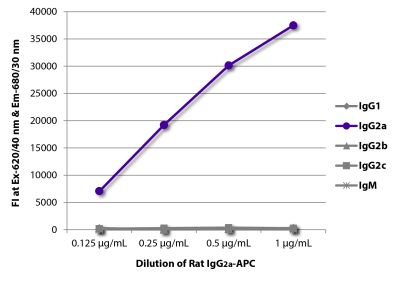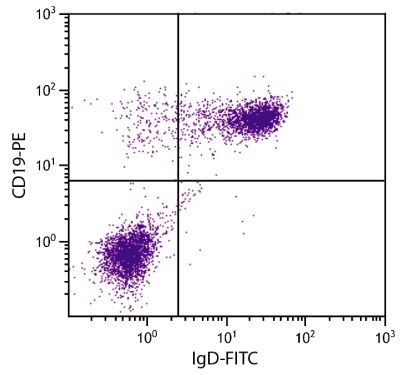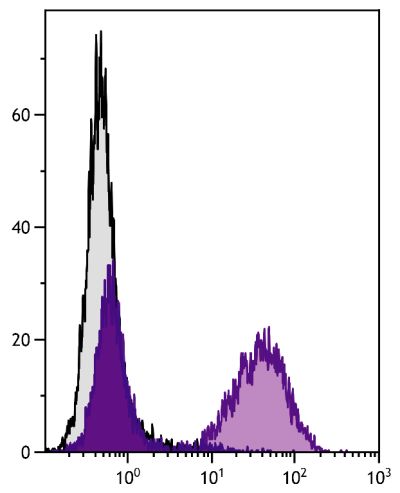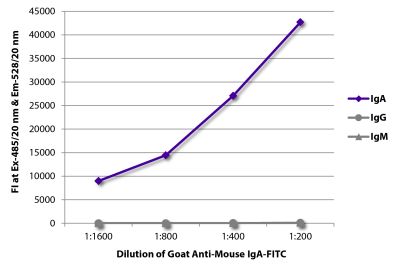Rat Anti-Mouse CD23-APC (2G8)
Cat. No.:
1585-11
APC Anti-Mouse CD23 antibody for use in flow cytometry assays.
$249.00
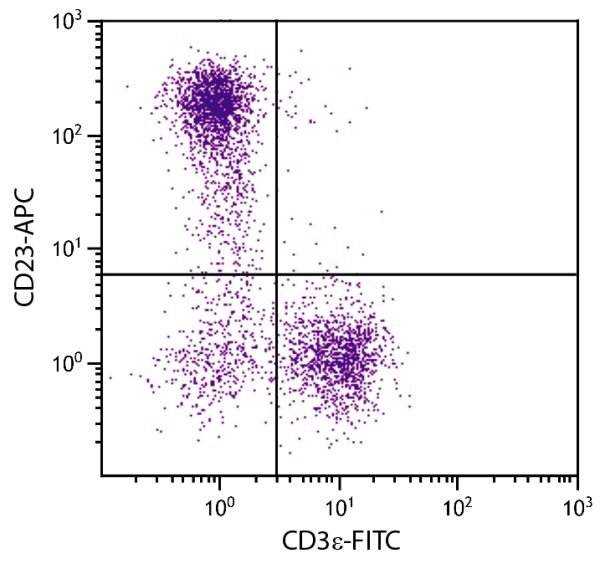

| Clone | 2G8 |
|---|---|
| Isotype | Rat (LOU/M) IgG2aκ |
| Isotype Control | Rat IgG2a-APC (KLH/G2a-1-1) |
| Specificity | Mouse CD23 |
| Alternative Names | FcεRII, BLAST-2, low affinity IgE receptor, Ly-42 |
| Description |
The CD23 antigen is the low affinity IgE Fc receptor, which is a 45-49 kDa protein with 38 and 28 kDa fragments. It is expressed on most mature, conventional B cells (but not on peritoneal CD5+ B cells) and can also be found on the surface of T cells, macrophages and platelets. It is distinct from the high affinity IgE receptors found on basophils and mast cells which mediate allergic reactions. The low affinity receptors are thought to play a role in isotype specific immunoregulation. The regulation of CD23 surface expression appears to be integral with the complex IgE system which involves interactions of cells, cytokines, antibodies and regulatory factors. CD23 has been described as a 'membrane bound cytokine,' in that the soluble cleavage products of CD23 are themselves able to act as cytokines in vitro. |
| Immunogen | FcεR isolated from B cell lymphoma cell line M12.4.5 |
| Conjugate | APC (Allophycocyanin) |
| Buffer Formulation | Phosphate buffered saline containing < 0.1% sodium azide and a stabilizer |
| Clonality | Monoclonal |
| Concentration | 0.1 mg/mL |
| Volume | 1.0 mL |
| Recommended Storage | 2-8°C; Avoid exposure to light; Do not freeze |
| Applications |
Flow Cytometry – Quality tested 6-13 Immunohistochemistry-Frozen Sections – Reported in literature 2 ELISA – Reported in literature 3-5 |
| RRID Number | AB_2794986 |
| Gene ID |
14128 (Mouse) |
| Gene ID Symbol |
Fcer2a (Mouse) |
| Gene ID Aliases | CD23; Fce2; Fcer2; Ly-42 |
| UniProt ID |
P20693 (Mouse |
| UniProt Name |
FCER2_MOUSE (Mouse) |
Documentation
Certificate of Analysis Lookup
Enter the Catalog Number and Lot Number for the Certificate of Analysis you wish to view
- 1. Rao M, Lee WT, Conrad DH. Characterization of a monoclonal antibody directed against the murine B lymphocyte receptor for IgE. J Immunol. 1987;138:1845-51. (Immunogen)
- 2. Gibb DR, Shikh ME, Kang D, Rowe WJ, El Sayed R, Cichy J, et al. ADAM10 is essential for Notch2-dependent marginal zone B cell development and CD23 cleavage in vivo. J Exp Med. 2010;207:623-35. (IHC-FS)
- 3. Pongratz G, McAlles JW, Conrad DH, Erbe RS, Haas KM, Sanders VM. The level of IgE produced by a B cell is regulated by norepinephrine in a p38 MAPK- and CD23-dependent manner. J Immunol. 2006;177:2926-38. (ELISA)
- 4. Kelly AE, Chen B, Woodward EC, Conrad DH. Production of a chimeric form of CD23 that is oligomeric and blocks IgE binding to the FcεRI. J Immunol. 1998;161:6696-6704. (ELISA)
- 5. Padro CJ, Shawler TM, Gormley MG, Sanders VM. Adrenergic regulation of IgE involves modulation of CD23 and ADAM10 expression on exosomes. J Immunol. 2013;191:5383-97. (ELISA)
- 6. Seagal J, Edry E, Keren Z, Leider N, Benny O, Machluf M, et al. A fail-safe mechanism for negative selection of isotype-switched B cell precursors is regulated by the Fas/FasL pathway. J Exp Med. 2003;198:1609-19. (FC)
- 7. Diamant E, Keren Z, Melamed D. CD19 regulates positive selection and maturation in B lymphopoiesis: lack of CD19 imposes developmental arrest of immature B cells and consequential stimulation of receptor editing. Blood. 2005;105:3247-54. (FC)
- 8. Bockamp E, Antunes C, Maringer M, Heck R, Presser K, Beilke S, et al. Tetracycline-controlled transgenic targeting from the SCL locus directs conditional expression to erythrocytes, megakaryocytes, granulocytes, and c-kit-expressing lineage-negative hematopoietic cells. Blood. 2006;108:1533-41. (FC)
- 9. Chen X, Esplin BL, Garrett KP, Welner RS, Webb CF, Kincade PW. Retinoids accelerate B lineage lymphoid differentiation. J Immunol. 2008;108:138-45. (FC)
- 10. Esplin BL, Welner RS, Zhang Q, Borghesi LA, Kincade PW. A differentiation pathway for B1 cells in adult bone marrow. Proc Natl Acad Sci USA. 2009;106:5773-8. (FC)
- 11. Barral P, Sánchez-Niño MD, van Rooijen N, Cerundolo V, Batista FD. The location of splenic NKT cells favours their rapid activation by blood-borne antigen. EMBO J. 2012;31:2378-90. (FC)
- 12. Rasmussen JW, Tam JW, Okan NA, Mena P, Furie MB, Thanassi DG, et al. Phenotypic, morphological, and functional heterogeneity of splenic immature myeloid cells in the host response to tularemia. Infect Immun. 2012;80:2371-81. (FC)
- 13. Ren W, Lagerstedt K, Grimsholm O, Stern A, Sun J, Fang Y, et al. Uncoupling of natural IgE production and CD23 surface expression levels. PLoS One. 2013;8(4):e62851. (FC)
See All References


